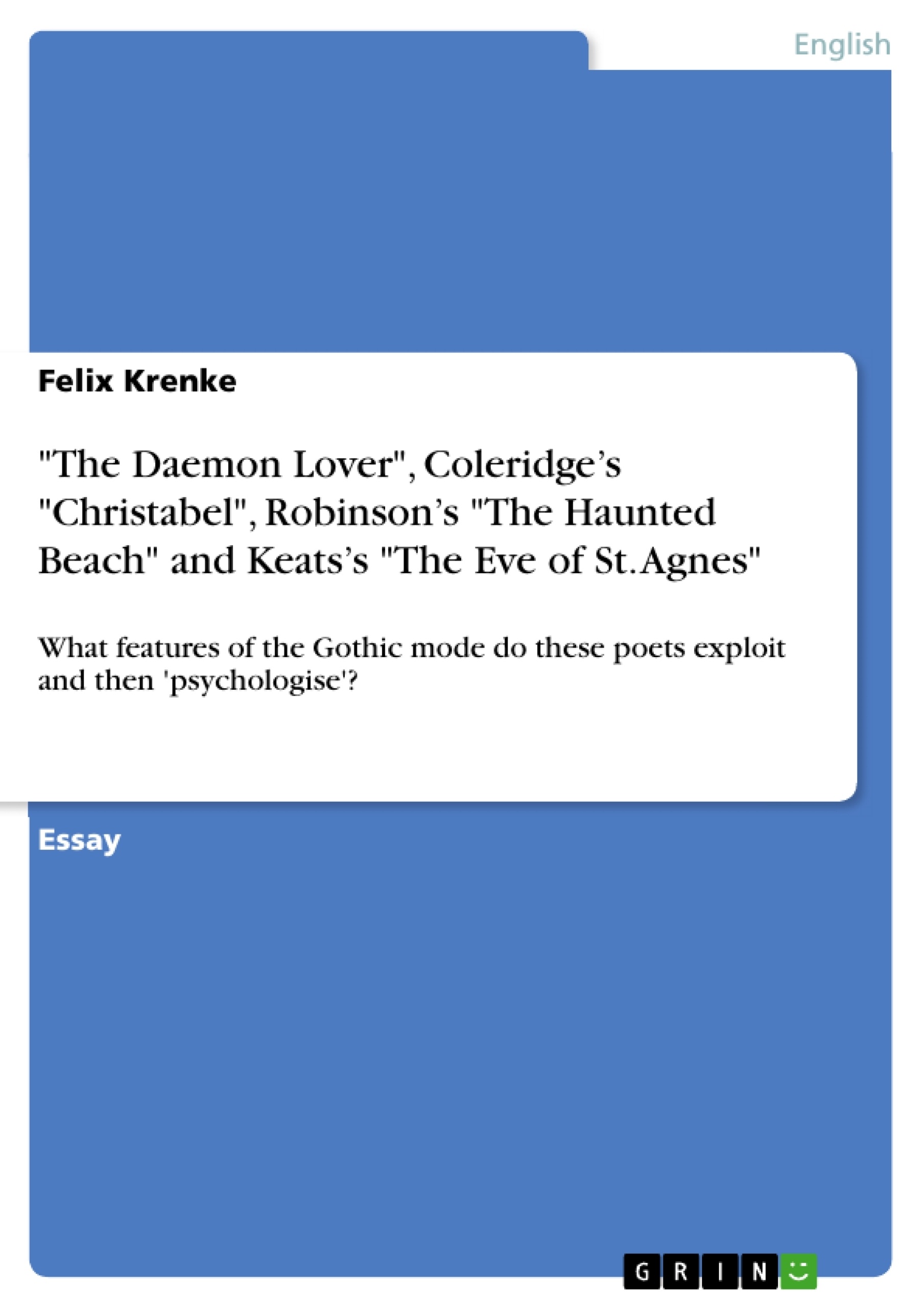The supernatural is one aspect, perhaps the most important one, of the genre of Gothic fiction or poetry. Although supernatural themes can be identified in all pieces of Gothic literature the presentations differs vastly, especially when it comes to the Romantic period in which the Gothic genre gained attention and popularity. Said popularity and its simplicity are the reasons for its vilification by well known poets at the time. Contrary to the fact that Gothic literature has been demeaned and criticised as worthless by Romantic authors like William Wordsworth, Samuel Taylor Coleridge and their contemporaries by cause of its conformity to the people's taste, some features of Gothic fiction can be found in Romantic poems. One could argue, that this is owed to the fact that the poets mentioned above attempted to increase their degree of popularity amongst the readers of Gothic fiction, but I hold the opinion that this would be a false accusation. They undeniably used certain features of the Gothic genre in some of their Romantic poems, but in ways which can be considered to be of great elegance and use for the Romantic period as a whole.
In the following essay I am going to compare the treatment of the supernatural in the traditional Scottish ballade 'The Daemon Lover' to Coleridge's 'Christabel', John Keat's 'The Eve of St Agnes' and Mary Robinson's 'The Haunted Beach'. Subsequent to the juxtaposition of these different approaches to the supernatural I will examine how the Romantic poets implemented Gothic features into their works. I argue that the Gothic features in these poems serve as symptomatic representations of human emotions.
Inhaltsverzeichnis (Table of Contents)
- Introduction
- The Supernatural embedment in Romantic Poetry
- 'The Daemon Lover'
- 'Christabel'
- 'The Haunted Beach'
- 'The Eve of St Agnes'
Zielsetzung und Themenschwerpunkte (Objectives and Key Themes)
This essay compares the treatment of the supernatural in four works: 'The Daemon Lover', Coleridge's 'Christabel', Robinson's 'The Haunted Beach', and Keats's 'The Eve of St. Agnes'. The essay then examines how the Romantic poets implemented Gothic features into their works. It argues that the Gothic features in these poems serve as symptomatic representations of human emotions.
- The role of the supernatural in Gothic literature and poetry
- The use of Gothic features to represent human emotions
- The relationship between the supernatural and the natural in Romantic poetry
- The different ways in which Romantic poets utilized the Gothic mode
- The relationship between the supernatural and morality in these works
Zusammenfassung der Kapitel (Chapter Summaries)
'The Daemon Lover' is a Scottish ballade that explores the themes of victimization, debility, and fear of the supernatural. The supernatural, embodied by the daemon lover, is portrayed as a persuasive and destructive force. In Coleridge's 'Christabel', the supernatural is used to draw a clear contrast between Geraldine and Christabel, highlighting themes of evil, devoutness, sexuality, and purity. Geraldine's inexplicable behavior serves as a source of fascination and fear.
In 'The Haunted Beach', the supernatural enhances the Gothic mood, creating a sense of gloom and mystery. The spectres contribute to the thrilling atmosphere, while the Gothic scenery further emphasizes the dark and eerie setting. John Keats's 'The Eve of St Agnes' employs the supernatural in a positive way, celebrating young love and creating a sphere of enchantment through the use of Gothic imagery. The supernatural, associated with magic, spells, charms, and rites, is not a source of fear but of love and desire.
Schlüsselwörter (Keywords)
The essay focuses on the themes of the supernatural, Gothic literature, Romantic poetry, human emotions, morality, and the relationship between the natural and the supernatural. Key terms and concepts include victimization, debility, evil, devoutness, sexuality, purity, gloom, mystery, enchantment, love, and desire.
- Quote paper
- M. A., M. Ed. Felix Krenke (Author), 2014, "The Daemon Lover", Coleridge’s "Christabel", Robinson’s "The Haunted Beach" and Keats’s "The Eve of St. Agnes", Munich, GRIN Verlag, https://www.grin.com/document/1007985



